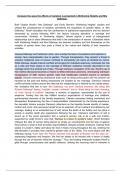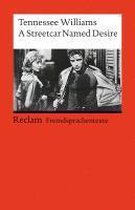Compare the ways the effects of isolation is presented in Wuthering Heights and Mrs
Dalloway.
Both Virginia Woolf’s “Mrs Dalloway” and Emily Bronte’s “Wuthering Heights” explore and
critique the consequences of isolation, prevalently the acquisition of outsider status. In “Mrs
Dalloway,” Woolf elucidates that the confinement of patriarchal expectations and the stoicism
demanded by society following WW1 are factors inducing alienation in marriage and
communities. Similarly, in “Wuthering Heights,” Bronte depicts a world of transgressive
relationships due to class differences that lead to the ostracization of women. Characters within
both Wuthering Heights and Mrs Dalloway are deemed outsiders and find themselves on the
margins of society when they pose a threat to the values and stability of their respective
societies.
Clarissa Dalloway and Catherine Linton, who overlap the lines of acceptance and rejection in
society, face marginalisation due to gender. Through transgression, they present a threat to
society’s traditional view of women confined to domesticity yet marry as dictated by norms.
While Clarissa, despite internal conflicts and longing for individual autonomy, embraces her role
as a wife and finds solace in her marriage to Richard, Catherine remains discontent in her
marriage which she entered out of duty. Through Clarissa’s navigation of the city, Woolf’s use of
free indirect discourse becomes a means to reflect individual autonomy, showcasing Clarissa’s
transgression of 20th century gender roles that traditionally confined women to domestic
spaces. Despite possessing paradoxical traits such as being preoccupied with the present yet
haunted by the past and feeling empowered yet isolated by her marriage, Clarissa’s internal
conflict primarily centres around the idea that her independence is defined by her marital status.
Her revelation that she is now “Mrs Dalloway; not even Clarissa anymore; this being Mrs
Richard Dalloway'' feeling “invisible; unseen; unknown” due to “there being no more marrying,
no more having of children'' becomes a moment of epiphany, exacerbated by the use of
anaphora. Feeling that she has fulfilled society’s expectations of marriage and childbirth,
quintessential elements of the female experience, Clarissa expresses feeling overlooked and
disregarded. Emphasising the flow of responsibilities characterised by the female experience,
the asyndetic tricolon prompts Clarissa’s reflections on the tripartite female identity of maiden,
mother and crone. She perceives herself to be an extension of her husband and defined by her
marriage, leading to an existential loss of self, where the death of her fertility and her place in
society is another death she experiences following the war. Clarissa’s estimation of self is
bound up in the social perception that a woman’s primary role is as a wife and mother,
supported by Leigh Kincer’s view that “Clarissa is a slave to society’s rules.” Woolf therefore
critiques the idea of women being placed as simply an accoutrement and the lack of agency
they hold as a result of their domestic responsibilities. Despite societal constructs, Clarissa finds
solace in London’s vitality and takes her time in freely moving throughout the city, relishing the
little liberation it provides from restrictive gender roles of the 1920s. The novel begins with Mrs
Dalloway having “burst open the French windows and plunged at Bourton into the open air,”
expressing happiness and freedom. We find her details to be imbued with a sense of vitality
through the use of dynamic verbs like “plunged.” Thus, the bustling metropolis enables Woolf to
glide through consciousness and spatial collisions, utilising the recurring motif of windows to
, symbolise both restriction and intellectual freedom for women.The dynamic imagery elucidates
Clarissa’s joy in observation, emphasising her transgressive and liberating act of roaming
London as a stark contrast providing autonomy from the confinement and repression
experienced within the domestic space following WW1. Alternatively, despite Catherine’s
compliance with societal expectations by marrying Edgar Linton out of duty, her subsequent
discontent within her marriage reveals the inherent limitations and constraints imposed on
women due to Victorian ideology encouraging morality, social respect and religious conformity
when Bronte wrote the novel. This extended to women expected to be submissive and obedient,
and self-sacrificing for the betterment of the family. Woolf’s metaphorical depiction of Catherine
and Edgar’s marriage as “not the thorn bending to the honeysuckles but the honeysuckles
embracing the thorn,” suggests Catherine’s wild, untamed nature and her passionate love for
Heathcliff embodied in the “thorn” whilst Edgar’s refined, domesticated demeanour and affection
for Catherine are symbolised by the “honeysuckles.” This portrayal subverts gender roles,
implying Catherine’s dominance and control in their relationship, which was atypical for
households in the 19th century due to patriarchal command. Not only reflecting Catherine’s
inner conflict between her wild desires and societal obligations, Woolf conveys the
unconventional dynamics within her marriage with Edgar, rendering her unable to reconcile her
conflicting emotions and societal demands. Additionally, Catherine expresses, “My love for
Linton is like the foliage in the woods: time will change it, I'm well aware, as winter changes the
trees.” The metaphor verbalises how as time progresses, her discontent grows, and she
acknowledges the inevitability of her feelings shifting and susceptible to external forces, akin to
the changing seasons. While marriage to Edgar was anticipated to resolve issues and fulfil
social ambitions, it instead has the adverse effect and exacerbates pre-existing problems.The
natural imagery employed by Woolf emphasises the complexity of emotion, transcending verbal
expression. Catherine’s self-awareness regarding the limitations of her love for Linton highlights
the tension between personal desires and social stability, threatening society’s expectations of
women being submissive and alienating her altogether. Overall, in comparing Clarissa’s
acceptance of societal roles and Catherine’s discontent within them, we see contrasting
responses to societal expectations placed upon women of their respective eras. While Clarissa
embraces her role as a wife despite internal conflicts, Catherine's dissatisfaction with her
marriage exposes the constraints imposed on women by Victorian ideology, isolating women as
a result of gender.
Septimus Warren Smith and Isabella Linton find themselves marked as outsiders due to the
alienation they experience from other characters. Septimus’ inability to communicate with others
about shell shock and Isabella's sense of isolation from her family due to her marriage both
contribute to their feelings of being isolated within their respective marriages and societies.
Whilst Septimus’ potential revelation about shell shock challenges the stoicism demanded by
society on mental health issues, Isabella's love for and marriage to Heathcliff, a man of lower
social class, defies family loyalty and traditional gender roles. Septimus's traumatic experiences
during the First World War become a lens through which Woolf critiques the societal power
dynamic that neglects and dismisses the emotional struggles of veterans. Often Woolf’s
omniscient narration focalises the perspectives of Septimus and Mrs Dalloway in order to
elucidate the congruence of their postwar experience. The firing of the motorcar acts as another





